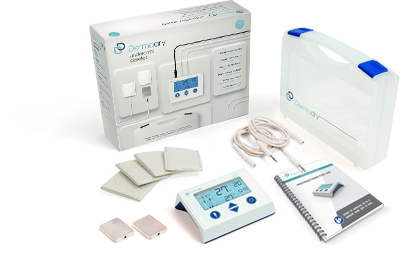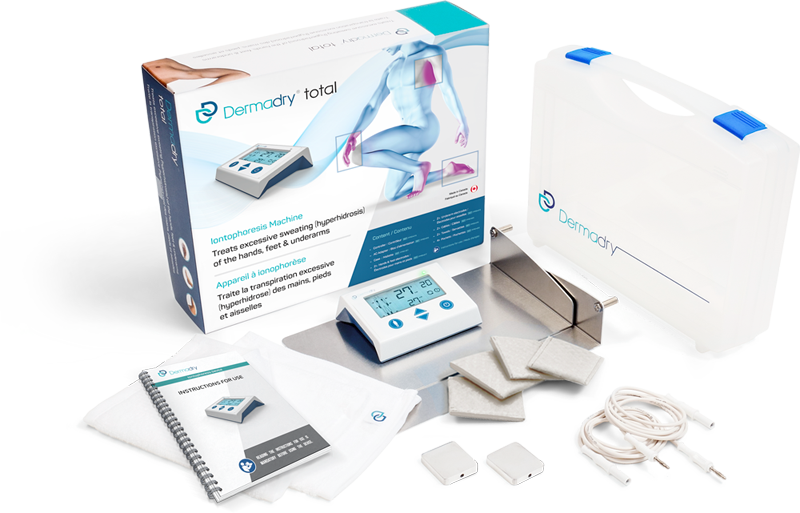Dermadry® BLOG
7 Ways To Manage Excessive Sweating
By Sam Nardi
2022 Feb 22nd
Dermadry Team
Dermadry Team
Feel like you sweat more than the average person? Well then you may need a treatment that is better suited to your sweating needs, rather than the average person’s. Excessive sweating on its own is a medical condition known as hyperhidrosis (hyper = excess, hidrosis = sweat). It affects approximately 5% of the population, so even if you don’t suffer from it, if you’ve ever been in a room or at an event with more than 20 people, chances are that someone there (including you) had hyperhidrosis. It’s more common than most people think!
Like other normal bodily functions, many people don’t like talking about sweat, even though everyone sweats, and it’s a crucial function of the human body. While it’s thought to affect approximately 1 in 20 people, the real number may actually be much higher than that. Due to a lack of awareness that excessive sweating is a treatable medical condition, many people never seek treatment for it, for various reasons stemming from lack of knowledge to shame. A good indicator as to whether you suffer from hyperhidrosis, is if you constantly find yourself feeling like you sweat more than others, think about sweat all the time, or base any of your decisions based on sweating.
While there is no magic cure for hyperhidrosis, there are a lot of treatment options. Consult our list of 7 ways to manage excessive sweating to discover more and see what treatment is best suited for your needs. Many of these require prescriptions, so we encourage you to open up to your doctor about your condition. Telemedicine, aka getting a prescription online, is another option for those who may feel shy or embarrassed to talk about this in-person.
Antiperspirants
If you suffer from hyperhidrosis, then you may have already tried a range of antiperspirants and deodorants to varying but often disappointing levels of success. If you’re one of the lucky ones who only has a mild case of hyperhidrosis, then regular antiperspirants may work for you, but if your sweating level is more moderate to severe, then you’re better off trying clinical-strength antiperspirants or prescription-only antiperspirants that are only available through your doctor, as these contain a very high percentage of aluminum salts. We recently put five of the most popular antiperspirants for hyperhidrosis to the test, learn about our results here. Antiperspirants are mainly designed for underarm usage, but also exist in other formats for other parts of the body such as the hands, feet, underarms, face/scalp, trunk, and groin. Antiperspirants are ideal for those looking for relief from mild sweating and an inexpensive treatment option, but not ideal for those with a sensitivity to aluminum (especially in higher formulations) or those who sweat a lot.Injections
Botulinum toxin injections, more commonly known as Botox injections, are a popular way to treat hyperhidrosis. These injections work by essentially temporarily paralyzing the nerves, which controls the sweating in the injection area. When your nerves can’t signal your sweat glands to produce sweat, the sweating significantly decreases. Botox is only FDA approved for the treatment of primary axillary (underarm) hyperhidrosis, however many specialists will use it off-label to treat other areas of the body. It is not always recommended for hands as it can cause temporary pain and weakness in the hands, nor the feet as they are too sensitive. It is most effective for the underarm region, and is also commonly used to treat the forehead and scalp regions. This type of treatment is ideal for those who have access to a licensed injector, and are looking for long-lasting effects. This effect wears off after several months (generally 4-12 months, depending on what area you are treating) and then must be redone. Treatment sessions can cost upwards of US$1,000 for each treatment zone, so it is not the most affordable option if you can’t get it covered by insurance.Iontophoresis
Excessive sweating? There’s a machine for that! Iontophoresis treatment for hyperhidrosis is one of the most popular ways to treat the condition due to its high effectiveness, safety, and affordability. It is a non-invasive, drug-free, and needle-free treatment that is generally done at home with a small, portable medical device. It’s the ideal solution for those who don’t like needles, invasive procedures, and would rather do their treatment in the comfort of their home while watching TV rather than having to make appointments and go in-person to treat their sweating. Additionally, this is great for those who suffer from excessive sweating of the hands, feet, and/or underarms—the three areas most commonly affected by hyperhidrosis, and want an all-in-one solution. Iontophoresis technology works by directing a mild current to the skin, which neutralizes the overactive signal between the nerves and sweat glands. This leads to a reduction in sweating levels, even in the most severe cases! Dermadry offers a home-use iontophoresis device that has a 98.3% success rate in visibly reducing sweating. The Dermadry Total is a one-time buy and is currently on sale for US$349!Microwave Thermolysis
Microwave thermolysis, known commercially as miraDry, is a way to permanently treat excessive sweating of the underarms. It uses thermal energy to permanently destroy sweat glands in the underarm region. The procedure is done with a non-invasive handheld device that delivers electromagnetic energy beneath the underarm skin resulting in thermolysis (decomposition by heat) of the sweat glands. Microwaves target the layer where the sweat glands are, therefore not burning the surface of the skin. It can also help eliminate body odour emanating from the underarm region (bromhidrosis) and underarm hair permanently. The availability and cost of this treatment varies by location. Due to it having to be done in a licensed practitioner’s office, the treatment is only available in select areas. The procedure itself is also quite costly, generally costing up to US$3,000 per treatment session. Some require one treatment session, while many require two or three treatment sessions for satisfactory dryness. This is an ideal treatment for those who live in an area that offers it, have the budget for it, and are looking for a permanent reduction and who also suffer from bromhidrosis, aka excessive body odour.Medications
Medication for hyperhidrosis can be prescribed by a doctor to reduce sweating. These are not designed specifically for excessive sweating, but can work by blocking the chemicals in nerve endings that regulate sweat glands. However, blocking these chemicals results in full-body dryness, as these medications are systemic and do not target specific areas of the body. This means that they decrease sweating and moisture all over the body, even where sweating is not a problem. This can lead to undesired and serious side effects, which are often worse than the sweating itself. These oral medications for hyperhidrosis are called anticholinergics and will come under several different names such as glycopyrrolate and robinul. Medications could be a temporary solution for those sweating excessively from several large areas on the body. However, these are medications that incur a recurring cost and are not suitable for the long-term.These medications are prescription-only, so you’ll have to talk to your doctor to see if they’re right for you. Some have experienced success with these medications, particularly those with full-body sweating.Moisture-Wicking Apparel
Not a “treatment” per say, but a good way to manage sweating for those who don’t sweat too much and just want an added layer of protection, particularly during hot and/or stressful days can invest in some moisture-wicking apparel, including absorbent sweat pads, which often come built-in to “sweat-proof” t-shirts. These won’t stop or reduce your sweating in any way but will keep you feeling dry and will stop sweat from reaching your clothing and leaving behind sweat stains. Look for clothing made of moisture-wicking fabrics, which help wick sweat away from the skin and let it evaporate more efficiently. If sweaty armpit stains are a concern of yours, armpit pads, whether on their own or built-in to t-shirts may be ideal to help you feel dry and comfortable during the day and save your clothing from sweat and yellow antiperspirant stains. Read our guide on how to sweat-proof your wardrobe, and if you suffer from sweaty feet, read our guide on the best socks for sweaty feet.Natural Remedies
Are you looking for a “natural” way to treat excessive sweating, using herbal remedies or maybe products you already have around your house? While there’s no evidence that any of these so-called natural remedies work, in many cases, it doesn’t hurt to try! According to the International Hyperhidrosis Society, some natural remedies for hyperhidrosis include herbal substances such as sage tea or sage tablets, chamomile, valerian root, and St. John’s Wort. Other natural remedies that have been suggested to help hyperhidrosis include witch hazel, schisandra, and white sandalwood powder. In addition to these substances, acupuncture, biofeedback, hypnosis, and relaxation techniques have also been suggested as potential treatments. Some people opt to use mattifying products and substances, such as creams and powders to help them feel dry and prevent chafing or blisters to the skin caused by heat and sweat. These creams and powders won’t prevent sweaty but may help prevent you from feeling “sticky”, particularly during hot days. Some people notice an improvement in their sweating levels when they change their diet and lifestyle. Changing your diet to add and eliminate certain food groups may help reduce your general sweating level, but may not help if you’re suffering from primary localized hyperhidrosis. Read our list of foods that can help you reduce sweating, and what foods that may be causing you to sweat more.Learn more about how to treat hyperhidrosis
Read Dermadry’s hyperhidrosis treatment guide here, discover our product range below, and subscribe to our newsletter to get more content like this delivered straight to your inbox.Discover other hyperhidrosis ressources
For more information about hyperhidrosis and how to treat this condition, please visit our friends at SweatySwaggy.























